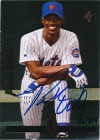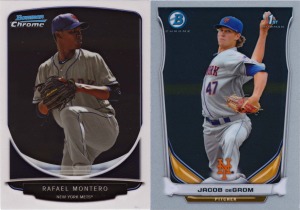In which I make my case to be the next Mets Executive VP of Ticket Sales
Another dismal season is coming to a close in Queens this weekend and it’s hard to come up with reasons for people to buy tickets to see the Mets wrap things up. Jacob deGrom? Shut down, as is former Met and fellow breakout rookie Collin McHugh. Juan Lagares? Yeah, he’s shut down too along with Dilson Herrera. David Wright? You get the picture. Even the Mejia stomp is likely off the menu with his sports hernia surgery scheduled for next week. Even if the product on the field doesn’t entice, at least there’s all the team history at the park. The Ebbets Field exterior, the Jackie Robinson Rotunda… If you’re lucky, you might be able to squeeze into the tiny gift shop before grabbing a burger at Shake Shack and hanging out with fellow lost souls on the “we seriously needed to poll the fans to figure out what to name this thing” Shea Bridge. Anyone who can sell people on this “experience” deserves a hefty bonus…
But that particular spot is vacant right now in the Mets front office. We’ll let the courts sort out just how that vacancy came to be, but for now I’ll take a stab at how to market the Mets to fans who are struggling to keep from jumping ship to the Yankees, Blue Jays, Nationals, Orioles, Pirates, Rays, or reruns of the 1994 Expos. And since I have never had a child out of wedlock, I at least meet that qualification. For everything else, I worry that being a fan of the team might actually be a strike against me, or at least that’s the picture I get from watching the way the organization is run. In any case, here are a few quick ideas for selling tickets to whatever team takes the field next year.
Season Ticket Holder Freebies
I may not know much about ticket sales, but I know that it all starts with the season ticket holders. These are the people and/or corporations that pay up front for a guaranteed seat at every home Mets game. Even smaller ticket plans are getting the royal treatment these days; buying tickets to 10 New Hampshire Fisher Cats games practically makes me a VIP. Season ticket holders (and, to a lesser extent, ticket plan buyers) need to be treated properly to ensure that they keep coming back.
But that’s not what happens at Citi Field. The most glaring example of disrespect to STHs is when seating-limited promotions are announced. These special offers promise a limited item like a bobblehead with tickets in a particular section. If you already have a seat elsewhere, you are told to buy another ticket and try to sell your usual seat if you want to get in on the deal. The message this sends is clear: “We already have your money, we have no motivation to keep you happy.” Other teams make sure that STHs are taken care of, why don’t the Mets? The last thing you should be telling someone who has given you thousands of dollars (tens of thousands in some cases) is that they need to buy another ticket if they want a promotional trinket. Maybe make it an option for an additional fee if the logistics are too complicated, but this needs to be fixed. This wouldn’t apply to ticket plan holders, but we’ll make sure they’re taken care of too.
Ticket Trade-Up Program
How many times this season have there been empty field-level sections while the unwashed masses crowd into the upper deck? That’s a bit of an exaggeration, but if nobody is buying the good seats, why not let the people who showed up sit down there without having to bribe an usher?
Here’s how it works: put a few kiosks by the entrances with flashing lights or something to make them look exciting. Starting a set time before the scheduled game time, people can scan their tickets for a chance at an upgrade. Only a limited number of seats will be made available and upgrades will be awarded at random. Each ticket or group of tickets (whatever was purchased together) gets one chance at an upgrade. If they win, they can get a seat upgrade for just a small processing fee (because everyone loves processing fees). If they lose, they get a coupon. Everyone’s a winner!
Ticket Trade-Down Program
Let’s say you’re a devoted fan and the last person you know who will still go for a ticket plan at the start of the season. There’s a game this weekend with a special 4 for $48 offer and your family is up for a game as a change of pace. The problem is that your lonely plan seat cost nearly that much by itself and you would have little chance of getting much more than $10 back if you sold it. You’re stuck choosing between taking the loss and going to a game with the family or going by yourself and letting the family watch on TV. Or just giving up on the team entirely because your plan tickets lose most of their value long before the game. But what if there was another option?
Paying for a plan up front guarantees a sale for the team. So why shouldn’t they guarantee the value of your ticket? Like with the bobblehead fiasco, this issue associates buying tickets early with losing money. That’s not a good way to do business. Instead, why not let plan holders trade the face value of their tickets down for multiple cheaper seats? (Exclusions and fees apply, excess value left unredeemed will not be refunded, all trade-downs are final.) You could also potentially turn this into a trade-up, putting the value of one ticket toward a more expensive seat or even combining multiple tickets (if originally purchased together) to make the most out of a cancellation. When the park isn’t selling out and the team isn’t winning, you need to sell your customers on value somehow.
Home Game Road Trips
Now we’re getting to the potentially LOLMets desperation moves. If we can’t get people to come to the games, why not just bus them in? After all, one of the biggest hurdles when it comes to going to a game at Citi Field is just getting to Citi Field. Between train fares, tolls, parking fees, etc., there really isn’t any way to get to a game from outside of New York City for much less than $50. There may be lots of fans out there in the tri-state area, but most of them would rather just watch on television. Why not try to turn them into paying customers?
This would take a fair amount of market research and logistics to pull off. Multiple bus routes, multiple stops per route, etc. would need to be figured out. Maybe throw in some refreshments or a t-shirt or promo item or something. And when everyone gets there, walk them up to the Pepsi Porch like they do for Bark in the Park so nobody gets lost. The game becomes just one part of the experience.
The Elephant in the Room
Now, none of this addresses the big problem, the matter of what happens on the field. Winning will put butts in seats more than any gimmick. Well, winning or hosting Derek Jeter’s final game. But since we lack the technology to scatter the end of Jeters career across the infinity of time and space, winning is all we have to work with. And winning just hasn’t been happening much lately. Maybe next year will be different. Maybe ownership will start spending. Maybe prospects will pan out and veterans will return to form. Maybe the tickets will sell themselves and the problem will be that people can’t get tickets rather than that they don’t want them. Until then though, the Mets need to embrace the fans who still stand by the team and do everything possible to make sure they enjoy the stadium experience. Because blaming low spending on poor attendance doesn’t help anyone.


Recent Comments